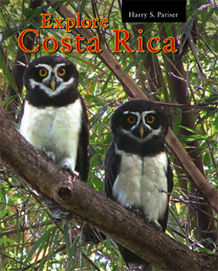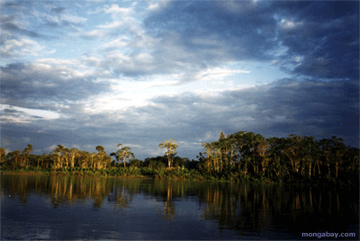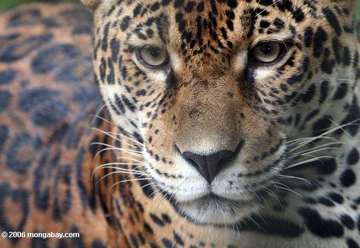Tips for visiting the rainforest for the first time
Advice for your first visit to the rainforest:
An interview with author Harry S. Pariser about rainforests
mongabay.com
March 4, 2008
Harry S. Pariser has been writing travel guides and articles for many years now. His most recent guide is Explore Costa Rica which has extensive information about the nation and its rainforests.
Mongabay How were you first introduced to rainforests?
While I was growing up, there were woods around my house, and I spent many happy hours exploring them. When I was 12, I penned my first Letter to the Editor,” asking that they be preserved as a park. Today, those woods are gone, replaced by subdivisions. There’re no more energetic bunny rabbits, lethargic salamanders, and scarey leeches for young children to enjoy.

Harry S. Pariser |
My first encounter with rainforests was a brief one. It came when I was in Rwanda. I had been in Uganda with a Dutch traveler at Kabalega Falls National Park, and we had met a middle aged Belgian Flemish couple. They offered him a ride to Burundi, their country of residence, and I accompanied them as far as Rwanda. We stopped by the side of volcano, and they hired a guide to take us to the mountain gorillas. This was before there had been publicity about the apes, before there were travel guidebooks to Africa, and I had little knowledge of mountain gorillas. Unfortunately the banker started getting heart pangs, and we had to turn back.
After that, I had brief encounters with rainforests in Sumatra and on Lombok in Indonesia.
The first rainforest I wrote about was the Caribbean National Forest. When I wrote the first edition of Explore Costa Rica (which had a different name then), I expanded the coverage of rainforest ecosystems in my Introduction substantially.
Mongabay What do you think about rainforest tourism in relationship to rainforest conservation?
In an idealistic world, forests would be preserved for their own sake — for the beauty they provide, for the respite from asphalt and malls, and because they shelter other creatures in an ecosystem independent of humans. The reality is that homo sapiens are short-term thinkers. Many individuals, especially in the equatorial regions, struggle just to survive. On one hand we have the short-term-thinking profit-driven multinational corporations and local companies who are interested only in immediate gain. The long term is of no concern. The local populace are, generally speaking, neither worldly nor aware about the true value of the forest. This makes for a lethal combination in terms of forest conservation.
 Explore Costa Rica |
Here in California we have enormous trees —redwoods and sequoias — some groves of which are protected. Visiting the groves we can see where a tree’s bark was removed, a passage through the base was carved in order to allow cars to pass through, and stumps where amazing specimens have been felled.
Although these trees now make up only 2% or so of California’s square acreage, fierce struggles are still being waged over attempts to log the remainder. While it might seem unfathomable to many of us that any more of these magnificent trees might be felled, the timber companies do not view things that way.
Today, these trees are being preserved because they have a constituency, a generation which has grown familiar with them. And this change has come about through tourism and environmental education.
This also holds true for the rainforests, except that here one faces a more daunting task. Most locals in the developing world do not have the disposable income to visit the rainforest and those residing nearby face a hardscrabble existence and are going to make money any way they can. The authorities are frequently corruptible, and corporations find them to be easily pliable.
However, there are many instances in diverse nations in many areas of the world where lodges, private reserves, and government reserves, parks, and wildlife refuges have preserved large areas of rainforest with largely positive results. One major change is that many local people are looking at their forests with fresh eyes.
I once visited the isolated ruins of the Mayan temple complex which stand by a Belizean river. The young, binocular-equipped guide there showed me a papaya tree with tiny fruit, a probable ancestor of today’s wondrous fruit. “If foreigners like our nature so much, why is it we can’t appreciate it more?” he stated.
That remark has stuck with me all these years. There are definitely challenges and problems with “ecotourism” but we need any successes we can get, however small. Certainly, visitors from abroad return to their countries with a new (or renewed) appreciation of the rainforest, and locals quickly learn from their visitors to respect the environment. Also, the presence of tourists spending money forces government officials to consider local conservation as a priority. This does not mean that they will necessarily appropriate the necessary funds and/or enforce laws against poachers and illegal loggers, but it is one inducement.
 Rainforest in Peru |
Rainforest tourism, on its own, can not preserve the large tracts of forest necessary for species conservation. What is really needed is preservation of large tracts and enforcement, and this must be a government policy. It can not be just lip service. It must be funded, and it is here that we run into problems.
While rainforest tourism can help local communities, it needs to be only one stream of revenue. It is also important to involve the locals, which is not always so easy. There is also the potential to overdo it, to bring in so many visitors that it negatively impacts the environment. This is in the process of happening in some of the more famous parks in Costa Rica, so it is always better to search out less popular areas.
Mongabay Why is it important to spend time in the rainforest?
You can’t really know anything about, say, Islam if you have never been in a mosque. You can read about it but it is not the same. Whatever your opinion on religion, mosques, especially centuries-old ones, are very special places. Similarly, one can’t simply imagine the rainforest.
There is a lot to be said for spending time in forests, whatever the variety, and really looking. I find a lot of trees, for example, to be totally amazing. I can see why Shinto, Japan’s native religion, was so respectful towards them and how they believed them to be inhabited by spirits.
Mongabay What lessons can we draw through visiting the rainforest?
We can learn that we are interdependent. We live under the illusion that we are separate from nature, that its laws to not apply to us. We believe falsely in our ability to “conquer” nature. When we see the interaction between bird and flower, ant and tree, and animals and seed dispersion, we can also apply that to ourselves. By taking this interaction more seriously — by trying to conserve and to actively lobby for conservation — we can act as a constituency for these areas.
Mongabay Where do you recommend going?
I’m really only familiar with parts of Asia and Latin America. Much of Asia has not taken the necessary steps to preserve their forests, and they are being deforested at an alarming rate. Some possibilities include national parks in Malaysia and the Aceh area of Sumatra which is now newly peaceful. Irian (West New Guinea) is a grand place to go but difficult to get around in (as is much of Indonesia).
 Jaguar in Colombia |
The Caribbean National Forest in Puerto Rico, which I cover in my guidebook Explore Puerto Rico, offers a good introduction. Belize has a number of reserves and parks, including some private holdings, but they are generally for higher-end travelers. I was not impressed by what I found in El Salvador and Honduras. Guatemala’s The Peten offers vast expanses of rainforests and Mayan ruins, but it is not easy to get around in the area, and it is not always safe.
Costa Rica has innumerable options. Many of these are high-end, but there are a substantial number of community run lodges and simpler expat-owned lodges as well. Laguna del Lagarto, Tiskita, Luna Lodge, Rara Avis, La Amistad, Las Esquinas, Nicuesa Lodge, and Hacienda Barú are some lodges which come to mind that offer rainforest adjacent to their property.
One problem is that many areas on the flatlands have already been cut, so what remains tend to be steep (and quite slippery when muddy). Also, adjacent forest tends to be either secondary or selectively cut, so you have to venture out a ways to find the primary forest.
Mongabay Is there a real difference between rainforests?
It’s important to point out that cloud forest is different from rainforest. The trees tend to be stubbier, animals are harder to spot, and the elevations are higher. So you should try to visit cloud forest and rain forest if you can. Tropical dry forest is perhaps scarcer than rainforest and well worth visiting. Two places I can recommend are Santa Rosa in Costa Rica and Guanica in Puerto Rico. It’s also worthwhile to go on a night hike with a guide. It’s absolutely amazing what you can see.
Mongabay What’s the best way to see wildlife?
 Red-eyed tree frog in Costa Rica |
I recommend a combination of two ways. First of all, if you have a good local guide, he or she can show you wildlife you might never see otherwise. Because they have lived there all their lives, guides know where the pit viper hangs out and which cecropia tree or trees the sloth resides. They can also identify birds and tell you about the area.
Don’t expect to see many animals other than insects. Many mammals are nocturnal, endangered, or both. Primates are easily spotted, but other species can be elusive. Birdwatching, ironically, is often better in clearings. However, there’s a lot to be said for seeing them deep in the forest.
In addition to going with a guide, you should also try to venture out on your own. One way to potentially see wildlife is just to sit quietly. You never know what might come by. It’s important to recognize that you need to stay on trails, because this is wilderness and people have gotten lost and died. Most lodges with forest reserves have trails and, often, maps to match.
Because you can see entirety of trees lining their banks, rivers often offer a grand way to see birds, reptiles, and amphibians. Kayaking is a great way to explore. In his book Belize by Kayak, author Kirk Barrett tells of spotting a jaguar on a sandbank as he navigated a bend in this river. While I would not count on seeing a jaguar, this is a great way to add to your trip.
Mongabay How should one plan a trip?
I would spend time reading about the rainforest and trying to understand some of the the innumerable and quite complicated symbiotic relationships. If venturing to Costa Rica (for example), I would read up on the history of the parks and learn something about the current political situation and how that relates to environmental conservation on the ground.
I would try to find one place (or two at a maximum) and stay there. Travel time eats into the time you can be spending in a forest, so a quality trip will mean less travel. I have a sidebar in Explore Costa Rica called “How to Choose a Rainforest Lodge” along with one titled “Picking a Tour.”
 Explore Costa Rica |
I would not overload myself with wildlife or birding books however. Many lodges will have them, and the principal species you will see are covered in any good travel guidebook.
Remember that early morning and late afternoon are the best times to visit. That means that you may have to forfeit some beauty sleep and trade it for afternoon shuteye.
Mongabay What preparations should one make before venturing out?
Bring water, mosquito repellent (!!), binoculars, other gear, and any wildlife identification charts you might need.
Mongabay How else might one participate?
Volunteer programs are a great way. But be sure to ask for references from former volunteers. Not all places treat their volunteers well. I was initially startled to find that many places charge volunteers to stay there and work for free, but that’s just the reality of the economics of these places: they need the money.
Mongabay How can people purchase copies of your travel guides?
They can be ordered through any bookstore, and they can also order them on the internet.
The websites are
http://www.ecocostarica.com and http://www.savorpuertorico.com
I also have a free update for Costa Rica on the Internet at:
http://www.savethemanatee.com/CR/CRupdates/ExploreCostaRica_update.pdf
You might also want to take a look at
http://www.catch22.com/~vudu/yapen.html and
http://www.savethemanatee.com/Rain/















